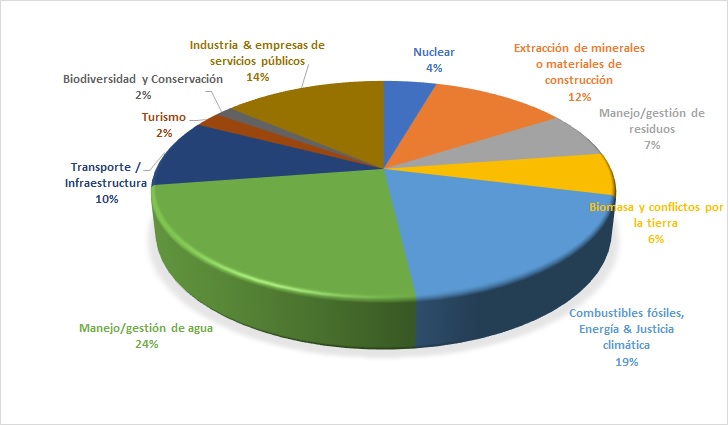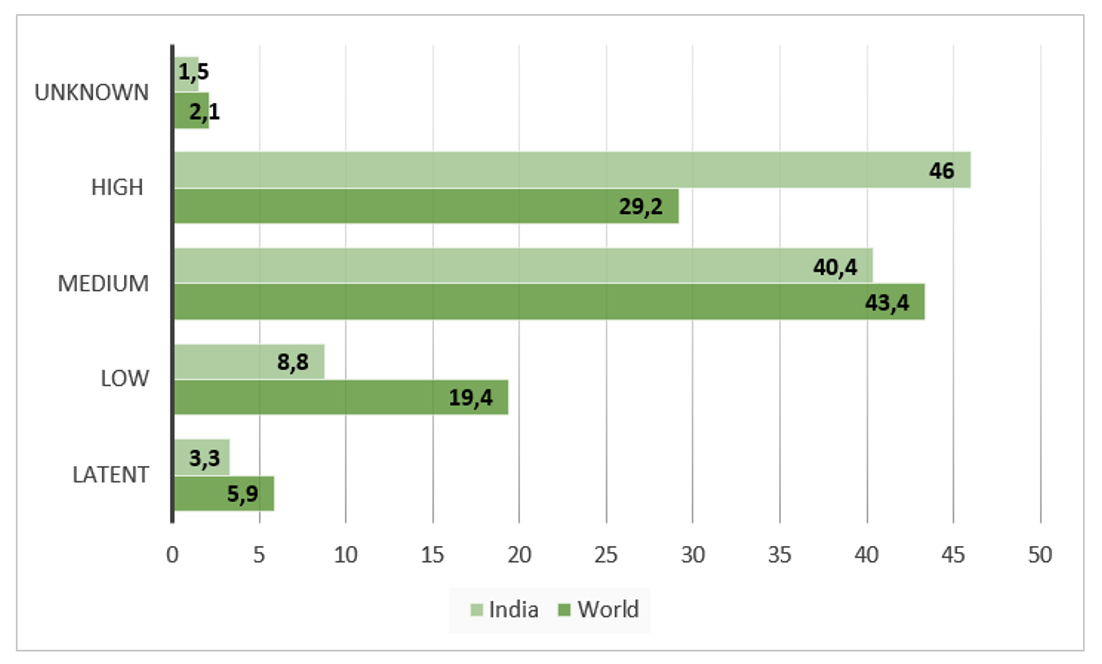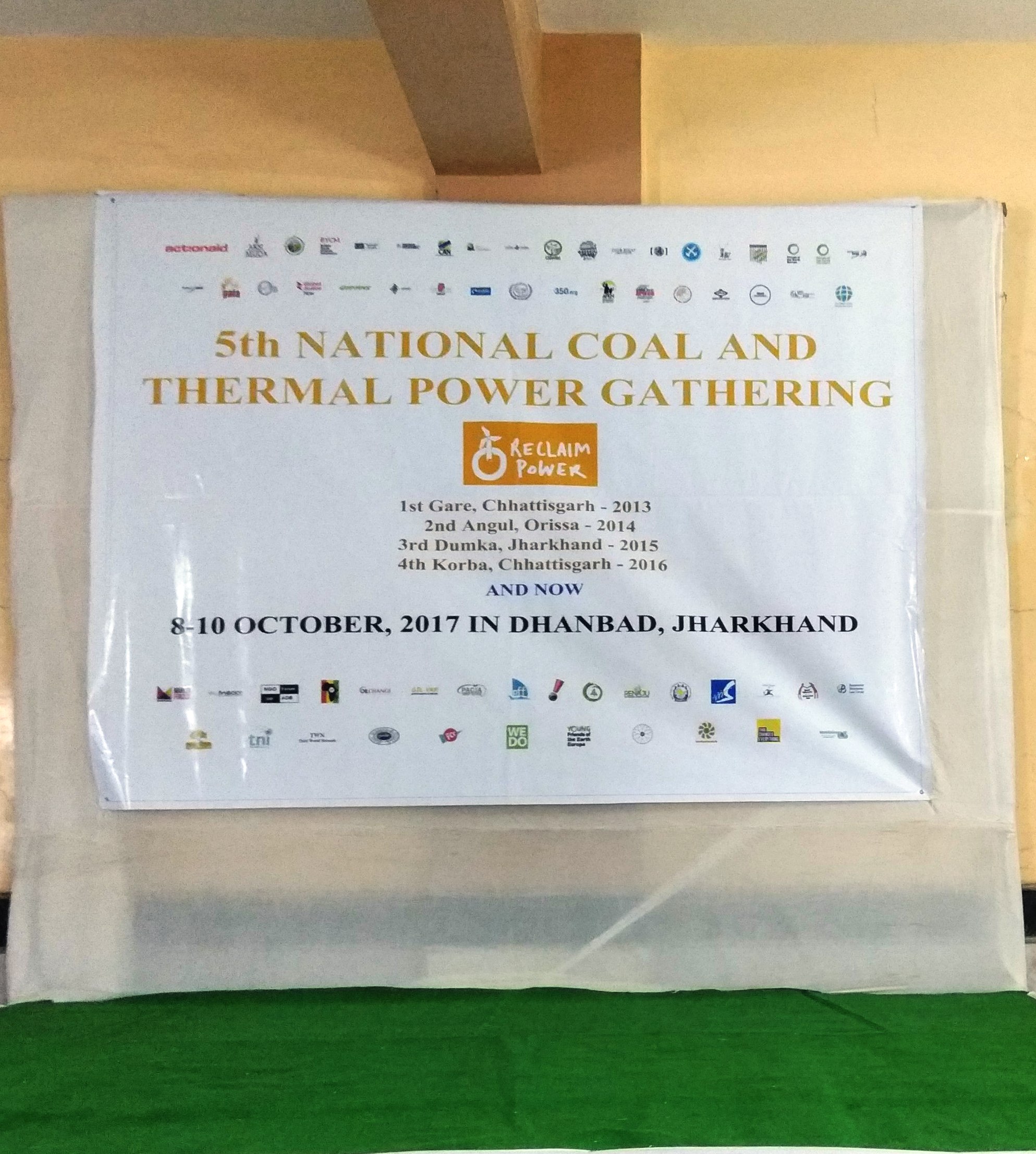Brototi Roy*
Abstract
This article provides a bird’s eye view of environmental justice movements in India. Using a combination of the Environmental Justice Atlas (EJAtlas) database, field research and analysis of grey literature, I look at intensities of conflicts, judicial tools which contribute to empowering the protests, changing slogans, and the old and new synergies and alliances within the movements in the country. Descriptive statistics and specific illustrations are used to provide first insights into the above-mentioned areas of environmental justice movements in the Indian context. I then discuss the meaning of success for an environmental justice movement and conclude with some scope for further research.
Keywords: Environmental justice movements, intensity of conflicts, political ecology in India, National Green Tribunal, Forest Rights Act.
Introduction
The rapid pace of urbanization and industrialization implies that natural resources are appropriated as inputs in massive quantities across the world. Similar was the case of the Indian economic liberalization of 1991. However, unlike most of the global South, India provides a case for ‘internal colonialism’ rather than an international one, characterised by ‘extractivism’ in resource rich regions similar to the ones in Africa and Latin America due to changing social metabolism (Svampa, 2013; Martinez-Alier et al., 2016; Bisht, 2018).
This article provides a bird’s eye view of ecological distribution conflicts caused by increasing resource extraction in India using the environmental justice atlas (ejatlas) database which reports 270 cases [1]. The next section describes the theoretical framework and the methodology. The third section, traces a short history of environmental justice movements in India followed by the current status of conflicts in the country, sub divided into 10 categories. This is followed by an analysis of three crucial aspects of environmental justice movements in India- intensities of mobilizations, languages of protest and synergies and alliances, and how they relate to successful outcomes. The concluding section discusses the need for in-depth and collaborative research, specifically in a South Asian context.
Theoretical Framework and Methodology
Ecological distribution conflicts (Martinez-Alier and O’Conner, 1998) are studied in political ecology (Martinez-Alier, 2005) as struggles emerging due to inequalities in power and income and are embedded in the broader context of race, class and gender inequalities (Robbins, 2004). The Environmental Justice Atlas, which was launched in March 2014, is a tool created to document and catalogue such ecological distribution conflicts worldwide. The theoretical framework, rooted in activist knowledge and the bottom-up methodology of creation of the data collection form of the EJAtlas is explained by Temper et al. (2015). Each case entered in the atlas has many parameters, such as source of conflict, details of the project, impacts, outcomes, mobilizations etc. I use descriptive statistics to shed light on three interesting characteristics of environmental justice movements in India. Using data from the EJAtlas, complemented with personal knowledge of the environmental justice movements through fieldwork and secondary literature review, I focus on three aspects of environmental justice movements in India, viz intensities of struggle, empowerment of protests via the judiciary and connections and alliances to analyse how they shape the outcomes of ecological distribution conflicts. I also use specific examples to strengthen my arguments.
Environmental Justice Movement in India
The environmental justice movement in India has a long history. The Chipko Andolan of 1973 is attributed as the first environmental justice movement of the country (Guha, 2000). However, even before that, early grassroot resistances to the British rule, such as the Bengal peasant revolt of 1859-63 against Indigo plantation had ecological undertones (Akula, 1995) and have resemblances to present day protests against industrial tree plantations in the global South (Gerber, 2011). Gandhi’s freedom movement also rang with concerns for the ecosystem and its people, who inhabited the seven hundred thousand villages of the nation, by advocating a model of self-sufficiency, and opposing industrialization (Guha, 1995). After independence, there was a heavy boost to large infrastructure for nation building such as multi-purpose dam projects and steel plants. Although this impetus on rapid industrialization couldn’t bring the desired economic growth, it unwittingly ushered in a wave of environmental justice movements in the country, such as the Narmada Bachao Andolan or the Appiko movement or the Silent Valley protest. Since 1991, when the Indian economy was liberalized, more than 200 conflicts have been reported in the EJAtlas, with the total number of cases as 270. Figure 1 provides a pictorial representation of the percentage of cases in each of the ten categories from the EJAtlas.
Image 1: Distribution of all cases from India into the 10 EJAltas categories. Author: B. Roy.

Intensity of Conflicts
In the EJAtlas database, each conflict can be categorized as unknown, latent, low, medium or high intensity conflicts. Latent ones are the conflicts which are still brewing and have no visible organizing for the time being. The low intensity cases have some local organization while the medium ones have more visible mobilizations such as street protests, rallies etc. The high intensity cases include more widespread mass mobilization, often including violence. Unknown intensity cases are the ones for which there isn’t sufficient information.
In India, more than 85% of the cases are either high (46%) or medium (40.4%) intensity ones. The low and latent intensity cases together constitute 12.1% with 1.5% of the cases remaining unknown in terms of their intensities. The total number of high intensity cases is 125, with the four categories of water management (28), fossil fuels and climate change (26), industrial and utilities conflicts (20) and mineral ores and building extraction (18) together constituting about three-fourth (92) of all the high intensity cases. There are 24 cases of low mobilizations, which entails some local organization, and 110 cases of medium intensity conflicts which entails visible mobilizations through demonstrations, sit-ins etc. This is different from the global picture, which has cases of medium intensity as the most frequently occurring one (43.3%). Figure 2 illustrates the percentages of intensity of conflicts for world and India.
High intensity cases in India are the most frequent in categories which often have either the occurrence or the anticipation of large-scale displacement of people, be it for water management which often involves large dams or fossil fuel extraction such as the destruction of huge areas of forest land for opencast coal mining.
There are two main reasons why most of the cases (86.4%) in India are either high or medium intensity ones involving visible mass mobilizations and often marred with violence. Firstly, this can be substantiated by the fact that forms of mobilizations against ecological distribution conflicts follow common patterns of social protests, which involve large gathering of people, often to also put moral pressures on the state. Secondly, India has the highest number of murders of land and environmental defenders in South Asia, and the second highest in Asia after Philippines (Global Witness, 2016) validating the presence of violence during mass mobilizations and beyond.
Image 2: World and India Percentages of Intensity of Conflict. Author: B. Roy.

Empowerment of Protest
Since the Chipko Andolan organized 45 years ago, one of the main way of protest has been to bodily stop a project by being prepared to either be imprisoned or die, be it hunger strikes (bhookh hartal) often unto death if the demands aren’t met or jail bharo andolan (occupy the jail). A history of strong social movements provides a unique vocabulary of protests in India. The basic premise of non-violent direct action, which follows from the Gandhian principle remains. Modifying the Gandhian notion of Satyagraha according to their own context, such as Jal Satyagraha for Narmada Bachao Andolan (EJAtlas, 2016a), the Kafan Satyagraha and Koyla Satyagraha (EJAtlas, 2016b) against coal mining in tribal areas of central Indian states of Chhattisgarh and Jharkhand and Zameen Samadhi Satyagraha (EJAtlas, 2017a) against land acquisition in Rajasthan.
Slogans such as ‘Jaan Denge par Jameen Nai’ (We will give our lives but not our lands) also highlight the strong attachment that people have to their land, which is often an extension of their cultural and ancestral heritage. One reason for using such slogans is also that the threats of violence and death are very real (Global Witness, 2017). However, in the recent years, the slogans have changed their tune, with the new ones being more empowering, such as ‘Na Jaan Denge, Na Jameen’ (We will neither give our life, nor our land). It is difficult to pinpoint the exact sequence of events which has led to the change in mobilization, and is a scope for further research, but it is very relevant to note how the environmental justice movement in India might be moving towards empowering people to seek their rights.
This can be possibly attributed to the two legal tools which were introduced in the last ten years and have been useful in the fight for environmental justice in India, namely the National Green Tribunal which was set up in 2010 and the Forest Rights Act, 2006 which was operationalized in 2008.
The National Green Tribunal was created through an Act of the Parliament of India, called the National Green Tribunal Act, 2010, drawing inspiration from Article 21 of the Indian Constitution which promises the right to a healthy environment to every citizen of India. The legislate Act of Parliament defines the National Green Tribunal Act, 2010 as follows,
«An Act to provide for the establishment of a National Green Tribunal for the effective and expeditious disposal of cases relating to environmental protection and conservation of forests and other natural resources including enforcement of any legal right relating to environment and giving relief and compensation for damages to persons and property and for matters connected therewith or incidental thereto.”
From 04.07.2011 till 28.02.2018, the tribunal had disposed off 22090 cases with 3164 cases still pending.
The Forest Rights Act, which is expanded as the Scheduled Tribes and Other Traditional Forest Dwellers (Recognition of Forest Rights) Act, 2006, is a key piece of forest legislation passed in December 2006. In its preamble, the act recognizes the historical injustice meted out to scheduled tribes and other traditional forest dwellers. It seeks to secure traditional rights over forest land and community forest resources, and to establish democratic community-based forest governance. FRA emerged as a legislative response to a national grassroots movement to record the rights of forest dwelling communities whose rights were not recorded during the consolidation of state forests in the colonial regime and in the post-Independence period, many of whom have been displaced for industrial and conservation projects without rehabilitation due to being labelled as ‘encroachers’ on forest land (CFR-LA,2016). Section 4(5) of the Act requires that no member of the forest dwelling Scheduled Tribes (ST) or Other Traditional Forest Dwellers (OTFD) shall be evicted or removed from forest land under his occupation till the recognition and verification process is complete.
The process of recognition and verification laid out in FRA is currently the only legal process for determining the genuine right holders and their rights on forest land. This is a very powerful tool, as now, legally companies or the state can’t begin their projects until the recognition and verification process is complete. However, in the last ten years, there have been multiple cases from across the states where the process hasn’t been following, including cases where there has been clear violation of FRA (EJAtlas, 2017b). So far, only 3 per cent of the minimum potential of Community Forest Resource (CFR) rights have been achieved. Yet, in cases which involve traditional communities and forest dwellers, which are relevant for many of the categories of the EJAtlas classification, be it fossil fuel and climate justice, biomass and land conflicts or mineral ores and building extractions, it becomes very relevant in empowering people to assert their rights.
Alliances and Synergies
The need for alliances across and within movements is felt strongly in India. All the historical movements, which have been able to deter or delay large project have built alliances across geographies, themes and societies.
One example of such synergies is the Kashipur Anti-bauxite mining movement (EJAtlas, 2017c). Since there were multiple conflicts and movements in Odisha during this period, it was strengthened by the interactions between different struggles. People of the Baliapal (anit-nuclear) and Chilika (anti-shrimp aquaculture) movements came to Kashipur and explained how they fought and won their rights. When the people of Kashipur heard about the success of the protest against BALCO when the leaders of Gandhamardan Surakhya Samiti came and explained their methods of protest, they were more motivated to keep the struggle alive (Naik, 2012). These alliances also went beyond state borders. In the coal valley of Jharkhand, a movement called the Karnapura Ghati Bachao Andolan (Save the Karnapura Valley Movement) was started to save the biodiversity hotspot and tribal heritage in the late 1980s. Sundarlal Bahuguna, one of the leaders of Chipko movement visited twice the valley, to share information about the success and strategies of the Chipko Andolan (personal interview with Bulu Imam).
Alliances, especially for conflicts against the same commodity, also includes international collaborations. In the case of coal, many international NGOs working for climate justice are involved, as can be seem from this image of a recent gathering of anti-coal activists in Jharkhand, India.
Image 3: Banner of the 5th National Coal and Thermal Power Gathering (Author: Brototi Roy)

Another example of building synergies, across different sections of the society, is the Goa Against Coal movement (EJAtlas, 2017d) where people living in the port town of Vasco Da Gama, coming from a diverse range of socio-economic background have been protesting against transport of coal in their region. In the public hearing about the expansion of the Mormugao port, residents all spoke against the project, including environment activists, engineers, lawyers, canoe fishermen, trawler fishermen, students, grandmothers, Roman Catholic priests, politicians from the Congress, Nationalist Congress Party, Aam Aadmi Party, fringe local parties, and even an minister from the ruling Bharatiya Janata Party, amongst which there was not a single deposition in favour of the project, indicating that the Union government faces formidable resistance to its plans.
Conclusion
In India, despite the high intensities of protests, new legal tools of empowerment, peaceful mass mobilizations, and synergies within and across environmental justice movements, the success of the protest remains uncertain at best. In the EJAtlas, out of the 270 cases from India, only 30 have been labelled ‘success’. The above two examples of Kashipur and Goa despite a long drawn and socially cohesive resistance aren’t success cases either. However, there are 132 cases labelled ‘unsure’ which constitute almost half of the total (48.7%) cases.
What determines the success of an environmental justice movement is subjective, and changes depending on the context and the stakeholder in question. In the EJAtlas, the categorization of an environmental justice movement being successful, unsuccessful or unsure depends on the opinion and understanding of the person filling in the case. Although there is a general trend that when either a project is stopped or promised compensation and rehabilitation is carried out, an environmental justice movement is considered successful, however, there are also cases where some activists consider a movement successful for delaying projects or helping in mobilizing people elsewhere. Thus, what constitutes and deters successful outcomes of massive protests remains a scope for further research.
Going beyond India, we are witnessing more and more ‘cooperation’ and ‘collaboration’ between the different countries of South Asia for financing large infrastructure projects in territories of vulnerable communities, which are leading to conflicts, such as Indian financing in Sri Lanka (Camisani, 2017) or the Indian involvement in the Rampal power plants (Misra and Mookerjea, 2017). Hence another area of future research, which will be more relevant in the coming years, is an in-depth analysis of how projects and conflicts are interconnected in a South Asian context, and the possibility to build alliances either against similar corporations or similar commodities. The EJAtlas has an option to link any conflict with similar cases elsewhere, be it cases where one institution is financing large scale ‘development’ projects harming the environment, or different cases where a single big project is affecting multiple sites beyond national borders etc. In this manner, it provides a good first step into making visible the connectedness of conflicts, and scope for further understanding the need for alliances of the protests to strengthen the movement against similar companies or commodities.
This article was an attempt to provide a bird’s eye view of environmental justice movements in India, by understanding the intensities, synergies- old and new, and two new judicial tools which empowers the protests. However, it only scratches the surface on our understanding of environmental justice movements in India, and how it has evolved in the last forty-five years.
References
Akula, V.K., 1995. Grassroots environmental resistance in India. Ecological Resistance Movements, pp.127-45. New York: SUNY Press.
Bisht, A., 2018. Ecological Distribution conflicts over mineral extractivism in India. Doctoral Dissertation. New Delhi: TERI SAS.
Camisani, P.B., 2017. Sri Lanka: a political ecology of socio-environmental conflicts and development projects. Sustainability Science, pp 1-15.
CFR-LA, 2016. Promise and Performance: Ten Years of the Forest Rights Act in India. Citizens’ Report on Promise and Performance of The Scheduled Tribes and Other Traditional Forest Dwellers (Recognition of Forest Rights) Act, 2006, after 10 years of its Enactment. December 2016. Produced as part of Community Forest Rights-Learning and Advocacy Process (CFRLA), India, 2016 (www.cfrla.org.in).
EJAtlas., 2016a. Dams construction on the Narmada River, India. In: Atlas of Environmental Justice. https://ejatlas.org/conflict/dams-on-the-narmada-river-india
EJAtlas., 2016b. Coal mining conflict in Hazaribagh with NTPC in Jharkhand, India. In: Atlas of Environmental Justice. https://ejatlas.org/conflict/illegal-land-acquisition-for-coal-mining-and-violent-protest-in-hazaribagh-jharkhand
EJAtlas., 2017a. Zameen Samadhi Satyagraha against land acquisition in Neendar village, Jaipur, Rajasthan, India. In: Atlas of Environmental Justice. https://ejatlas.org/conflict/zameen-samadhi-satyagraha-by-villagers-against-land-acquisition-for-infrastructure-of-neendar-village-jaipur-rajasthan
EJAtlas., 2017b. Direct violation of forest rights act in the mining belt of Surguja district, Chhattisgarh, India. In: Atlas of Environmental Justice. https://ejatlas.org/conflict/direct-violation-of-forest-rights-act-in-the-mining-belt-of-surguja-district-chhattisgarh
EJAtlas., 2017c. Kashipur anti-bauxite mining movement. In: Atlas of Environmental Justice. https://ejatlas.org/conflict/human-rights-and-environmental-violation-for-bauxite-mining-in-the-baphlimali-hills-of-kashipur-rayagada-district-odisha
EJAtlas., 2017d. Goa against Mormugao Port Trust coal projects, India. In: Atlas of Environmental Justice. https://ejatlas.org/conflict/goa-against-mormugao-port-trust-coal-projects
Gerber, J.F., 2011. Conflicts over industrial tree plantations in the South: Who, how and why?. Global Environmental Change, 21(1), pp.165-176.
Global Witness, 2016. In Dangerous Grounds. London: Global Witness.
Guha, R., 1995. Mahatma Gandhi and the environmental movement in India. Capitalism Nature Socialism, 6(3), pp.47-61.
Guha, R., 2000. The unquiet woods: ecological change and peasant resistance in the Himalaya. Berkeley: UC Press.
Martínez Alier, J., 2005. El Ecologismo de los pobres: conflictos ambientales y lenguajes de valoración. Barcelona: Icaria
Martinez-Alier, J., Temper, L. y Demaria, F., 2016. Social metabolism and environmental conflicts in India. In Nature, Economy and Society (pp. 19-49). New Delhi: Springer.
Misra, M y Mookerjea, S., 2017. Why New Delhi must withdraw from the Rampal Power Plants. Economic and Political Weekly, 52(18), pp.26-28.
Naik, I.C., 2012. Tribal women and environmental movement in India: A Study of Kashipur Block of Odisha. Contemporary Voice of Dalit, 5(2), pp. 153-162.
O’Connor, M. y Martinez-Alier, J., 1998. Ecological distribution and distributed sustainability. In Sustainable development: concepts, rationalities and strategies (pp. 33-56). Dordrecht: Springer.
Robbins, P., 2004. Political Ecology: A critical introduction, Critical introductions to geography. Malden, MA: Blackwell.
Svampa, M., 2013. Resource extractivism and alternatives: latin American perspectives on development. In Beyond Development: Alternatives Visions from Latin America. Transnational Institute/ Rosa Luxemburg Foundation, Amsterdam, pp. 117–144.
Temper, L., Del Bene, D. y Martinez-Alier, J., 2015. Mapping the frontiers and front lines of global environmental justice: the EJAtlas. Journal of Political Ecology, 22(1), pp.255-278.
—
* Institut de Ciència i Tecnologia Ambientals, Universitat Autònoma de Barcelona. E-mail: brototi.econ@gmail.com.
—
[1] To access the full list of cases from India, go to www.ejatlas.org/country/india.







